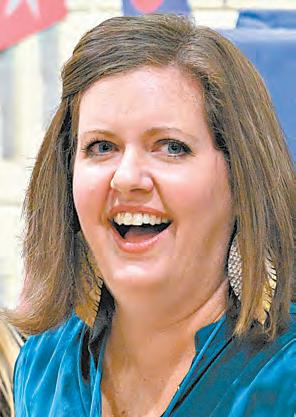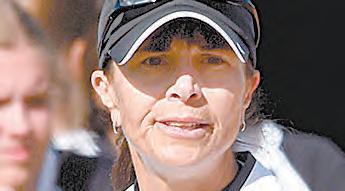L
By Emily Williams-Robertshaw
ooking back on pandemic closures that began nearly a year ago, Birmingham Botanical Gardens Garden Assessment Project Leader Molly Hendry, a Vestavia Hills native, remembers the bad but also the good. “When we shut the gates in the throes of spring, I was still coming to the gardens,” Hendry said, conducting essential work such as checking on irrigation systems, weeding and the like amid gardens in full bloom. “I felt this heaviness because nobody was getting to see this,” she said. Gardening in a public space can sometimes be frustrating, with visitors walking through freshly tended beds. But the lack of visitors outweighed any issues faced in normal operating days. There was time to do an overhaul of the Dunn Forman Rose Garden to fix drainage issues. Hendry was able to finish tweaking a perennial border in the Southern Living Garden she had been working on since 2018. “There were some good things that came out of it, but the lasting takeaway has been the joy that we get sharing the garden with people,” she said. It was also a time that proved just how much the gardens meant to people, as donors proved only too happy to support the BBG as key fundraising events were canceled, such as the Spring Plant Sale or Antiques at the Gardens, which this year was reimagined as Birmingham Blooms. Next month the gardens revives its biennial Native Plant Conference, and Hendry will be one of the speakers. According to a release, the March 11-14 event will highlight the resilience of native plants, along with topics ranging from conservation to design and education. The event series will include virtual presentations, roundtables and trivia, as well as on-site small group field trips.
A Winding Route
When she first started her schooling, Hendry had a plan to become a landscape architect, but because Auburn University didn’t offer a bachelor’s degree for the field, she settled for horticulture. “I just kind of fell in love with it,” she said. She had the opportunity to study abroad in England and travel to Italy to study the country’s great gardens. “I thought about just getting my masters in horticulture, but being in those gardens, I thought, ‘No. I want to make people feel the way that I feel when I see this place,’” she said. While pursuing her master’s in landscape architecture at Auburn, she took a year off to do something unexpected; she accepted an internship at a public garden in Delaware. “I fell in love with public gardens that summer,” she said. “I worked with a designer and thought that garden people are my people.” Upon completing her second degree, Hendry was given what she calls “the opportunity of a lifetime.” She was chosen for a coveted fellowship offered through the Garden Club of America. “They have been doing an exchange program through the United Kingdom and America since World War II, where they swap an American fellow and a British fellow,” she said. Hendry lived in the UK for about a year, spending time in eight different placements. “I was moving all over the country about every two months and it was a dream, but I felt like I would come back and work for an archi-
‘Slow Design’ ABOUT TOWN
OVER THE MOUNTAIN JOURNAL
Landscape Garden Professionals to Speak at Upcoming Birmingham Botanical Gardens Native Plant Conference
Photos courtesy Birmingham Botanical Gardens
4 • Thursday, February 25, 2021
Southern Highlands Reserve Executive Director Kelly Holdbrooks, left, and Birmingham Botanical Gardens Garden Assessment Project Leader Molly Hendry, right, are among a number of speakers scheduled to speak at next month’s biennial Native Plant Conference.
tecture firm as a plant person,” she said. Yet, the more time she spent working in these public gardens, the more she felt her relationship with the act of gardening and maintaining the plants to be a calling.
‘At Birmingham Botanical Gardens, I love that my whole job is to get people excited about gardens and being outside, growing things. I get the luxury of being able to observe and make measured decisions. I have a leg up because I get to know and understand the place itself and get to know the people that make the place what it is.’ MOLLY HENDRY
“I started feeling this nudge,” she said. “I never thought I would come back to Birmingham, but I just kept feeling this nudge. Then, this opportunity opened up at the BBG that is all of the things that I love doing.” In her role at the facility, she has the best of both worlds, aiding in design and strategic development while also spending time getting her hands dirty, working with volunteers and educating others. “At Birmingham Botanical Gardens, I love that my whole job is to get people excited about gardens and being outside, growing things,” she said. “I get the luxury of being able to observe and make measured decisions. I have a leg up because I get to know and understand the place itself and get to know the people that make the
place what it is.” Hendry oversees the more than 26 gardens that make up the Birmingham Botanical Gardens. She works to understand the history of each garden, its original intent, the people who had a hand in creating what it has become and where, in those spaces, things need to be tweaked to better serve its purpose. “If we get a grant or are approached by a donor, we can leverage the resources we have in one of those directions,” she said.
The Native Plant Conference
After a keynote opening presentation on March 11 from Southern Highlands Reserve Executive Director Kelly Holdbrooks, Hendry will lead a session about her wildflower studies. Her presentation, “Slow Design: Observation and Response as Our Most Valuable Garden Tools,” is inspired by her indepth studies that have been conducted in the Hugh Kaul Wildflower Garden since April 2019. She will discuss the garden’s history, which was created in the late 1960s and found its heyday in the 1980s. At one point, Hendry believed the garden needed a refresh. She sought help from worldrenowned landscape architect and author Thomas Rainer and his 2015 book “Planting in a Post-Wild World.” “I saw on his Instagram that he was going to be in town visiting his parents, so I reached out,” she said. “He ended up coming back and doing a workshop with us and helped create this plan and vision for our Kaul Wildflower Garden for the 21st century.” The key to the plan has been to let the plants speak for themselves. “We have over 900 native species in that garden,” Hendry said. “Any native plant enthusiast would just balk at that number. It’s a really incredible number of species, but the average Joe that walks in wouldn’t know that.”
Hendry explained to Hendry that one of the keys to grabbing the attention of the typical visitor is through color. “Before we actually go into this whole redesign phase, we need to just take a step back and watch the garden over time,” Hendry said. Her duty was to visit the garden and observe those species that demand attention. “In 2019, I started going out there at least once a week, but probably multiple times a week, to just walk around and observe and take lots of pictures,” she said. She focused only on the plants that grabbed her eye, ending up with 179 main contenders. Through what is now known as the KWG Phenology Project, she began tracking bloom times on a large chart. “Now I can see that this cardinal flower is in bloom for 12 weeks out of the year. That’s a really long time,” she said. “Then I look that this little trillium, and it’s only in bloom for two weeks. It has value but I need to use it in a different way.” The plants themselves will now lead the redesign. Those eye-catchers will draw the visitor in and lead them to learn more about their surrounding species that may not have the same “wow factor.” “There really has been value in taking a step back over two years and establishing what the problem areas are and being able to make measured decisions through first observing,” she said. In addition to her presentation, Hendry will lead an on-site field trip on March 14 through the Kaul Wildflower Garden. “In the Birmingham Botanical Gardens, we have so many gardens that are geared towards the homeowner and their own gardens,” she said. “Kaul is one where it feels more natural. People may not walk in and think they could do this in their own yard.” In her free time, Hendry also finds ways to help other people in their home gardens. She has observed a growing trend toward native plants but also to getting things done quickly. “They often don’t want to stop, observe and think,” she said. The thing about native plant life that makes a difference is that these plants want to grow in Alabama soil, she said. “There has been a Southern landscape that has been the same since the ‘80s where you just throw in the hollies or loropetalum shrubs,” she said. “You hack your crepe myrtles off in February because that’s what your dad did in his yard. “I think people are realizing that maybe that doesn’t have to be the way it is.” Hendry’s has noticed when working with younger homeowners a willingness to learn more about species that give back to the surrounding environment, such as pollinators and other plants that support the surrounding wildlife. “Their yard might be small, but it can be a critical piece in the wider landscape,” Hendry said. Events such as the Native Plant Conference allow people to learn more and even take a field trip to see these plants growing in a natural habitat. “We are hoping that Kaul becomes its epicenter,” she said. “We want it to be a garden that captures people’s minds and imaginations and points them outward to those wild places. Registration for access to all virtual events is $80 for members and $100 for non-members. Field trips are $40 each for members, or $50 each for non-members. For more information and a lineup of speakers, visit bbgardens.org/npc.php.




